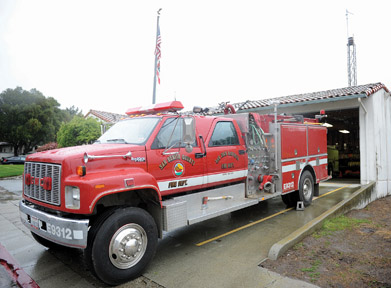San Juan Bautista fire department predates the city it serves
San Juan Bautista fire department predates the city it serves
One of the oldest, continuously operating fire departments in the state runs thanks to volunteers who devote hundreds of hours of their time to provide tiny San Juan Bautista with a level of emergency response services that it couldn’t otherwise afford.
The San Juan Bautista Volunteer Fire Department was established in 1868, a year before the city itself was chartered. It is as much a part of the town’s story as its historic downtown and the Mission square.
“For me personally, having been here almost 20 years, many times I’ve been ready to walk away, but seeing that year on the side of the engine really drives you to continue,” said Fire Chief Chris Finstad, a county maintenance supervisor for Santa Clara County. “A lot of our volunteers feel that way too.”
The city spends approximately $80,000 per year to help fund the fire department, according to City Manager Roger Grimsley. Equipment grants from state agencies help outfit the nearly 30 volunteers in the department, and many of them provide their own gear as well. It can cost up to $3,000 to properly outfit a firefighter, Finstad said.
Last year the department responded to approximately 260 calls, roughly evenly distributed between the city itself and San Benito County, with which the city has an agreement to provide additional coverage.
Most of the San Juan volunteer firefighters have jobs, while some are retired and some are going to school.
“We don’t just recruit anybody,” Finstad said. “Back in the day, you’d throw on gear and you’d run an engine. Now, we do a background check, there’s an interview process and just to get on an engine there’s 115 hours of minimum training and another 100 hours of medical training.”
Being a volunteer, which includes carrying a pager that can go off at any time of the day or night, “is a major commitment,” Finstad said. “I look at it as a second job. You have to be dedicated. A lot of people try it out and within a couple of months don’t do it anymore. You can get a call in the middle of dinner or in the middle of night.”
Volunteers range in age from 18 to the 60s, though there is no upper age limit. Three to four recruits are typically trained at a time, and the department is accepting applications now through May 15.
“The basic requirements are to have a driver’s license and be 18 years of age,” Finstad said. “We like to find people who are looking for the fire service as a career path. Some people have gone or are looking to go to a fire academy or are going to school for fire service.”
But the desire to make firefighting a career is not the only prerequisite.
“We have to look at the overall goal of protecting our community,” Finstad said.
Assistant Chief John Fox, who worked with the Felton Fire Department for more than 25 years and is now a food and drug investigator with the state Department of Health’s food and drug branch, said a “will to be there and a desire to be a part of it” are important criteria for potential volunteers, whose only compensation is $15 per call.
“We try to get some volunteers who are available in the daytime. Some are available only at night; it’s a mix,” he said. “We look where our gaps are.”
Volunteers are trained for four to six months, meeting two nights during the week or once during the week and once on a weekend during that time. They receive instruction on how to use fire fighting equipment, including how to ride in a fire engine, use the ladders and hose, and talk on the radio.
After their six months of training, volunteers are issued a pager and can respond to calls only if an officer or their training officer is on-scene.
“Then we can decide if they can cut it or not,” Fox said. “We want to see if they remember their training.”
Most people who volunteer make it through the probationary period, he said.
“If someone’s having a problem with ladders, for example, we’ll come down on another day and work with them on that,” Fox said. “Our goal isn’t to throw people out. It’s to make sure they’re trained. They’re going to be putting their lives on the line, so we’ve got to make sure they’re trained.”
Most of the calls to which the fire department replies are medical issues or car accidents. San Juan has only one or two structure fires per year, Fox said.
On average, 5.1 volunteers show up on a call to man the equipment, with another 1.9 people at the fire station itself.
The variety of experiences that the volunteers have is valuable to the department, Fox noted, as exemplified by a recent call for wires down near Anzar High School. One of the volunteer responders was an electrical lineman whose experience with and knowledge of power lines helped stabilize the situation.
San Benito County Supervisor Anthony Botelho, a former volunteer firefighter in his hometown of San Juan, said it has “always been there in service to the citizens of San Juan Bautista.”
“Many long-time families participated at one time or another in the fire department,” he said. “They provide an outstanding service to calls not only in the city but the areas that surround the city.”
He said that while some volunteers are looking to get experience in advance of a career in fire service, “for others – and particularly in San Juan – it’s about giving back and caring for the community in which they live. There’s always been a strong spirit of volunteerism in San Juan, whether it’s with the fire department, the church or service organizations that help the youth.”
For more information on the department, visit www.sjbfd.com.









